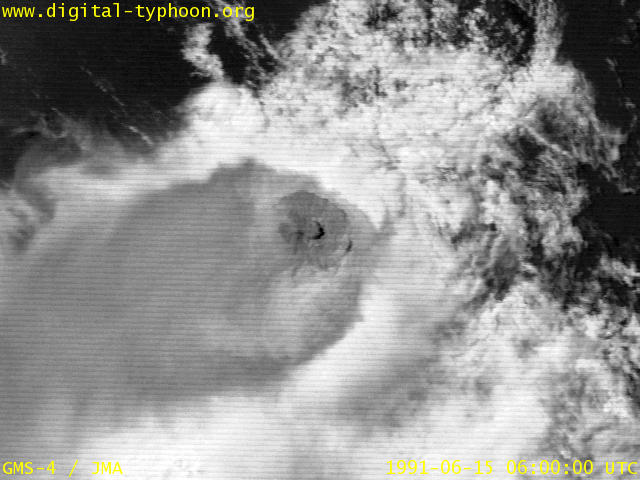
ピナツボ火山噴火直後のひまわり4号可視画像(撮影は現地時間13:42:10頃)。中心はピナツボ火山の位置(北緯15.13度、東経120.35度)、画像の範囲は東西480km、南北360km。
| ||||||||||
| ||||||||||
|
火山噴火に伴い、噴煙や火山灰が風に乗って流されます。その方向を推測するために、風向きマップをご利用下さい。
過去の火山噴火事例については以下のページで提供しています。
気象衛星は気象観測を主な目的としているが、気象以外の現象も観測することができる。例えば火山の噴火に関しては、可視画像で噴煙の広がり、赤外画像で地表温度の上昇などを観測することができる。
ここでは1991年6月15日13:42(現地時間)に始まったフィリピン・ルソン島のPinatubo(ピナツボ/ピナトゥボ)火山の噴火を取り上げる。ピナツボ火山の噴火は9時間続き、この噴火で大量の火山灰が噴出した。下の可視画像はちょうど噴火のすぐ後の現地時間13:42:10頃の撮影画像である。ピナツボ火山はちょうど画像の中心に位置するが、そこにきのこ状にたちのぼる噴煙と、その噴煙が雲頂に落とす陰が見えている。

ピナツボ火山噴火直後のひまわり4号可視画像(撮影は現地時間13:42:10頃)。中心はピナツボ火山の位置(北緯15.13度、東経120.35度)、画像の範囲は東西480km、南北360km。
なお、この画像に見えている雲の渦巻は台風199105号(YUNYA)である。この噴火では不運なことに、火山噴火と台風接近のタイミングが重なってしまった。そのため、噴出した火山灰は台風による雨に混ざってしまい、水分をたっぷりと吸った重い火山灰がルソン島の広範囲にわたって降ることになってしまった。このような重い火山灰が多くの家の屋根を押しつぶしてしまったことが、死者が増える一因になったと言われている。
またピナツボ火山の噴火は20世紀最大級の噴火と考えられており、噴出したエーロゾルが成層圏にまで達して長期間地球の大気を覆ったことで、大気下層の気温は一時的に下降することになった。この現象は地球温暖化の議論において、エーロゾルが地球温暖化に与える影響を見積るための貴重な実例を提供することになった。
|